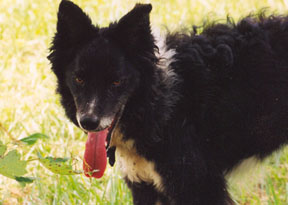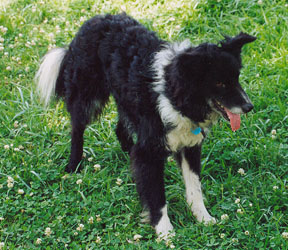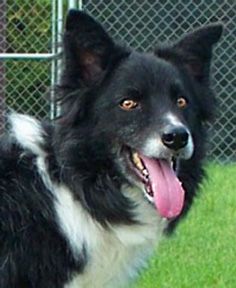
BACK
 |
Kip |
Last year, in August, some GLBCR volunteers represented rescue groups at an event called, "Bark in the Park". A man approached the rescue booth, asking how a dog qualifies for foster care. He was at the event with his two huge, white dogs (possibly Great Pyrenees), who he shows in confirmation. After a brief conversation, he walked off with his show dogs.
Soon, the man returned, dragging a skinny, scared Border Collie by a leash. He said his sister had found the dog and was willing to care for it. The sister housed the dog in a metal corn crib (in the summertime heat) for the past several months. The dog chased, killed, and ate her chickens which was why the dog was confined to the corn crib.
| Pulling the frightened dog, the man started to walk away, and the dog trembled with fear. The GLBCR members could not bare the thought of this dog's future without our help. The man gladly relinquished the dog, even providing medical records from the time the dog was a four month old pup! Once the man handed the leash to a volunteer, she and the dog found a cool, shady spot under a tree to become acquainted. She sat on the ground and the dog crawled into her lap, still trembling. Trying to comfort him, she stroked his coarse, dry coat and clumps of fur fell out in her hands. His curly locks hid his bony frame, yet when tenderly petting him, the ribs, spine, and pelvis clearly protruded. Tears rolled down her cheeks as her mind raced with thoughts of what this poor dog had endured. His life would never again be restricted to solitude with little to eat. Now, he would learn the joy of human companionship and a healthy diet. |
 |
That day, the dog given a new name, Kip, to start a new happy life. An emergency foster welcomed Kip into her home. She worked with Kip to build his confidence and enjoy the loving care of human companionship. Kip had been frightened of so many things for so long, he delighted in the security of this new home. Yet, his appetite was minimal. Concerned about this and his already too thin body, blood work was ordered. The findings reported all within normal range. Different strategies were used to stimulate his eating habits. Still there was little improvement, though he did gain some weight.
Ten weeks later, Kip was adopted to a lady who was interested in training Kip for agility. She taught him fun agility obstacles and he learned to LOVE tunnels. After five months of encouragement, Kip continued to balk at new, scary obstacles. She felt his gait was somehow in question and his eating was still a concern. An X-ray was in order to determine if there was a problem. The films were reviewed by a radiologist. The results suggested some mineralized discs in the lower neck. Kip's adopter felt he should not continue with agility training, so he was returned to GLBCR care.
 |
Kip's X-rays were mailed to another veterinarian, who specializes in problems of the neck, spine, and hips. His conclusion reports no injury, disease, or need for surgery or limited activity. Since there is a difference in findings, GLBCR will pursue another opinion to clear this question. So for now, Kip is enjoying foster care. He is running and playing with the other dogs. He does LOVE agility tunnels, but is much more a natural at herding. This is somewhat a problem with disc dogs, though he does not herd playing children. Nor is Kip interested in chasing cats. Though Kip previously ran to his crate for security, he only seeks crating for his meals. |
Kip weighs just over 30#, about 5# underweight, and stands 21.5" at the withers. His appetite is still not hardy, but by adding a B complex vitamin, he is beginning to finish a full portion at each meal. This vitamin, along with regularly scheduled meals and a slight change in kibble enhancements, may finally lead to a normal appetite and healthy weight.
Kip is looking for a loving human, who will not coddle him. He needs someone who will continue to build his confidence by standing tall, providing security, and encourage socialization. Kip should be exposed to new situations, with a matter-of-fact attitude, neither forced, nor pampered. It is easy to cuddle him and protect him. The hard part is allowing him to become more independent. If you have equal amounts of compassion and strength, Kip might just be the companion for you.
 |
For more on Kip, email Sheila |